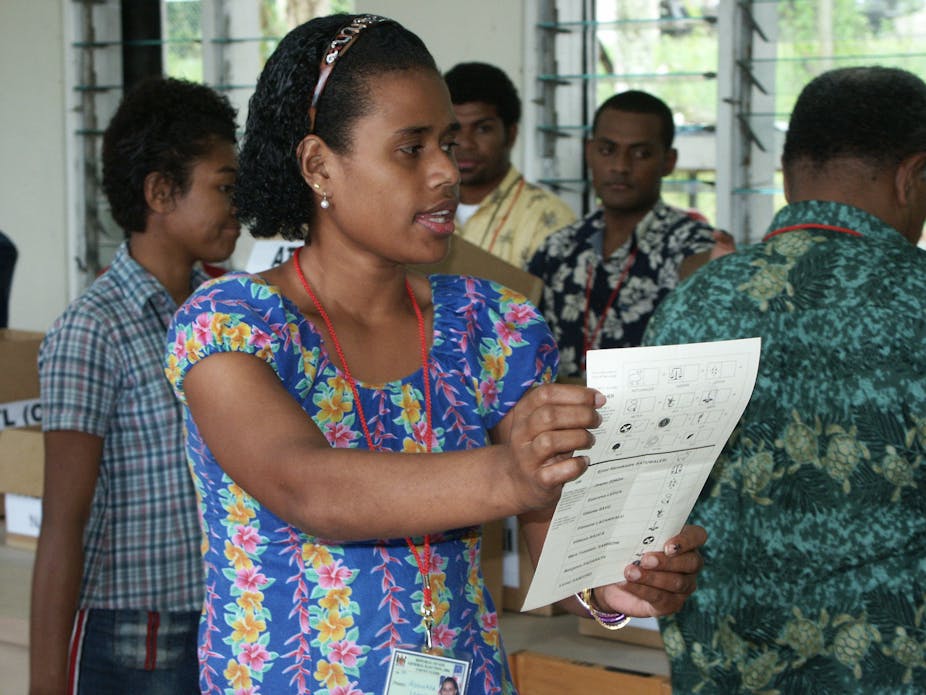In a region that has long had the worst representation of women in politics in the world, Fiji’s recent election delivered some good news: one in seven Fijian MPs are women, while the parliament now has its first female Speaker.

In one of the best results for women in Fiji’s history since independence in 1970, eight of the 50 MPs (16%) elected at the September 17 poll were women, up from 11% after the last election in 2006.
That result put Fiji slightly above the Pacific-wide average of 15% and closer to the global average of 22% of politicians. There are some countries where women’s political participation is much higher, led by Rwanda, Andorra, Cuba and Nordic nations. In Australia, 29% of federal politicians are women.
Since the election, that proportion of women MPs has dropped slightly to 14% – but only because one of the eight elected women, Jiko Luveni, vacated her parliamentary seat to become the Speaker. She is only the second female Speaker in the Pacific Islands, following the lead of the Cook Islands in the 1960s.
This election was also remarkable for how many major political parties went to the polls with women as their party presidents or leaders.
But there is still a long way for Fiji to go before it reaches what the United Nations considers a crucial benchmark of at least 30% women in national parliament.
And some of the attacks on prominent female candidates – including veiled rape threats – during the election campaign revealed that some voters in Fiji are still unhappy about more women stepping up into political leadership roles.
Women leaders
There are now a number of women holding leadership roles as presidents or party leaders. These include Ro Teimumu Kepa for the Social Democratic Liberal Party (SODELPA), Linda Tabuya for People’s Democratic Party (PDP), Tupou Draunidalo for the National Federation Party (NFP) and Lavania Padarath for Fiji Labour Party (FLP).

Jiko Luveni was also the president of the ruling Fiji First Party, led by prime minister (and former coup leader) [Frank Bainimarama](http://www.theaustralian.com.au/news/world/coup-leader-frank-bainimarama-set-for-victory-in-fiji-election/story-e6frg6so-1227062340812.
A former dentist, Luveni said last month that her elevation to Speaker was “more an achievement for women in general than it is for myself”.
Ro Teimumu Kepa was the leading woman candidate, scoring a total of 49,485 votes, followed by Tupou Draunidalo of NFP with 2966 votes, Salote Radrodro of SODELPA with 2300 votes and Luveni with 2296 votes.
Kepa became the opposition leader earlier this month in the first parliamentary sitting since the 2006 military coup.
Courage to stand up and be counted
Although she wasn’t elected, high-profile Independent candidate and democracy activist Roshika Deo – who was awarded US State Department’s Women of Courage this year – also made her mark.
Deo polled 1055 votes, falling short of the votes needed to be elected. But she proved to more popular than many more seasoned politicians who scored fewer than 1000 votes.
In praising women who have now become part of Fiji’s political growth, Luveni made a special reference to Deo’s impressive political journey.
However, as the Auckland Sun has reported, Deo faced vicious verbal attacks for her international profile as a feminist. Opponents posted photoshopped pictures of her as the fierce Hindu Goddess Kali, garlanded with skulls, and called for her to be “taken to the cassava patch” — a local euphemism for rape.
Like almost everywhere else in the world, politics in Fiji is still male-dominated, with men formulating the structures and rules of the political game.
Women who enter politics find that the political environment is often unfriendly or even hostile to them. Therefore, male-style politics may continue to discourage women entering politics in the next elections.
But over the last decade, women’s parliamentary representation has increased in Fiji. And one of the critical reasons for this rise is the impact of women’s organisations and women’s active participation in community and church groups.
Standing on other women’s shoulders
Women have come a long way since Adi Losalini Dovi became the first woman nominated as a member of Legislative Council and then elected to House of Representatives in 1972.
Even long before I was born, the late Irene Jai Narayan was a household name in the 1970s in her role as the National Federation Party president from 1976-79.
She was also known in Fiji’s political history as one of the longest serving opposition parliamentarians with NFP, who later absconded to the Alliance Party and then served as the Minister for Indian Affairs from 1987-1992 in the Rabuka-led military regime.
Taufa Vakatale was Fiji’s first female deputy prime minister from 1997-1999 in the Rabuka government. As a young student at the University of the South Pacific in the mid-1990s, I remember her as one of the very influential Ministers for Education of her time.
A woman’s place is in the House
Women have come a long way in carving their mark in Fijian politics.
With seven women parliamentarians and the nation’s first female Speaker, it will be interesting to see how women work together across party lines over the next four years. There is much work to be done to review existing laws, programmes and policies and to ensure adequate funding for women’s empowerment and gender equality in Fiji.
There’s some hope that with eight women inside parliament, women’s perspectives and interests are more likely to be taken into account and their concerns given higher priority.
The slogan “a woman’s place is in the House of parliament” is increasingly true in Fiji – and it offers some promise of greater social and political change in the Pacific.

